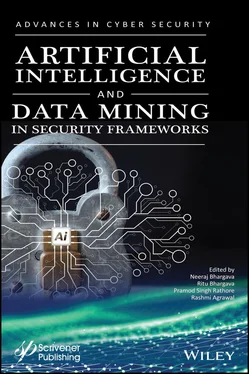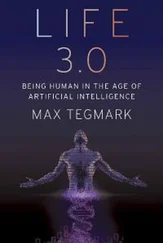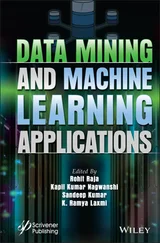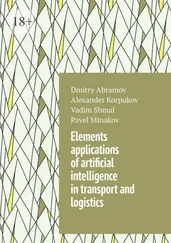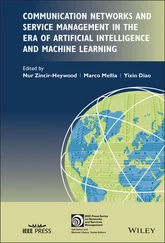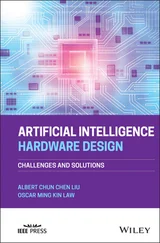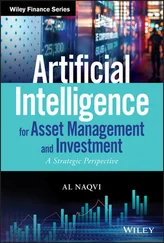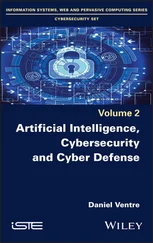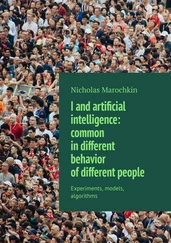1 Cover
2 Title Page
3 Copyright
4 Preface
5 1 Role of AI in Cyber Security 1.1 Introduction 1.2 Need for Artificial Intelligence 1.3 Artificial Intelligence in Cyber Security 1.4 Related Work 1.5 Proposed Work 1.6 Conclusion References
6 2 Privacy Preserving Using Data Mining 2.1 Introduction 2.2 Data Mining Techniques and Their Role in Classification and Detection 2.3 Clustering 2.4 Privacy Preserving Data Mining (PPDM) 2.5 Intrusion Detection Systems (IDS) 2.6 Phishing Website Classification 2.7 Attacks by Mitigating Code Injection 2.8 Conclusion References
7 3 Role of Artificial Intelligence in Cyber Security and Security Framework 3.1 Introduction 3.2 AI for Cyber Security 3.3 Uses of Artificial Intelligence in Cyber Security 3.4 The Role of AI in Cyber Security 3.5 AI Impacts on Cyber Security 3.6 The Positive Uses of AI Based for Cyber Security 3.7 Drawbacks and Restrictions of Using Computerized Reasoning For Digital Security 3.8 Solutions to Artificial Intelligence Confinements 3.9 Security Threats of Artificial Intelligence 3.10 Expanding Cyber Security Threats with Artificial Consciousness 3.11 Artificial Intelligence in Cybersecurity – Current Use-Cases and Capabilities 3.12 How to Improve Cyber Security for Artificial Intelligence 3.13 Conclusion References
8 4 Botnet Detection Using Artificial Intelligence 4.1 Introduction to Botnet 4.2 Botnet Detection 4.3 Botnet Architecture 4.4 Detection of Botnet 4.5 Machine Learning 4.6 A Machine Learning Approach of Botnet Detection 4.7 Methods of Machine Learning Used in Botnet Exposure 4.8 Problems with Existing Botnet Detection Systems 4.9 Extensive Botnet Detection System (EBDS) 4.10 Conclusion References
9 5 Spam Filtering Using AI 5.1 Introduction 5.2 Content-Based Spam Filtering Techniques 5.3 Machine Learning–Based Filtering 5.4 Performance Analysis 5.5 Conclusion References
10 6 Artificial Intelligence in the Cyber Security Environment 6.1 Introduction 6.2 Digital Protection and Security Correspondences Arrangements 6.3 Black Tracking 6.4 Spark Cognition Deep Military 6.5 The Process of Detecting Threats 6.6 Vectra Cognito Networks 6.7 Conclusion References
11 7 Privacy in Multi-Tenancy Frameworks Using AI 7.1 Introduction 7.2 Framework of Multi-Tenancy 7.3 Privacy and Security in Multi-Tenant Base System Using AI 7.4 Related Work 7.5 Conclusion References
12 8 Biometric Facial Detection and Recognition Based on ILPB and SVM 8.1 Introduction 8.2 The Proposed Methodolgy 8.3 Experimental Results 8.4 Conclusion References
13 9 Intelligent Robot for Automatic Detection of Defects in Pre-Stressed Multi-Strand Wires and Medical Gas Pipe Line System Using ANN and IoT 9.1 Introduction 9.2 Inspection System for Defect Detection 9.3 Defect Recognition Methodology 9.4 Health Care MGPS Inspection 9.5 Conclusion References
14 10 Fuzzy Approach for Designing Security Framework 10.1 Introduction 10.2 Fuzzy Set 10.3 Planning for a Rule-Based Expert System for Cyber Security 10.4 Digital Security 10.5 Improvement of Cyber Security System (Advance) 10.6 Conclusions References
15 11 Threat Analysis Using Data Mining Technique 11.1 Introduction 11.2 Related Work 11.3 Data Mining Methods in Favor of Cyber-Attack Detection 11.4 Process of Cyber-Attack Detection Based on Data Mining 11.5 Conclusion References
16 12 Intrusion Detection Using Data Mining 12.1 Introduction 12.2 Essential Concept 12.3 Detection Program 12.4 Decision Tree 12.5 Data Mining Model for Detecting the Attacks 12.6 Conclusion References
17 13 A Maize Crop Yield Optimization and Healthcare Monitoring Framework Using Firefly Algorithm through IoT 13.1 Introduction 13.2 Literature Survey 13.3 Experimental Framework 13.4 Healthcare Monitoring 13.5 Results and Discussion 13.6 Conclusion References
18 14 Vision-Based Gesture Recognition: A Critical Review 14.1 Introduction 14.2 Issues in Vision-Based Gesture Recognition 14.3 Step-by-Step Process in Vision-Based 14.4 Classification 14.5 Literature Review 14.6 Conclusion References
19 15 SPAM Filtering Using Artificial Intelligence 15.1 Introduction 15.2 Architecture of Email Servers and Email Processing Stages 15.3 Execution Evaluation Measures 15.4 Classification - Machine Learning Technique for Email Spam 15.5 Conclusion References
20 About the Editors
21 Index
22 End User License Agreement
1 Chapter 1 Figure 1.1 Network infrastructure [4]. Figure 1.2 System architecture [11].
2 Chapter 2 Figure 2.1 Privacy preserving data mining approaches. Figure 2.2 Flowchart of genetic algorithm. Figure 2.3 An overview of intrusion detection system (IDS).
3 Chapter 3 Figure 3.1 Artificial intelligence. Figure 3.2 AI for cyber security. Figure 3.3 Role of artificial intelligence in cyber security. Figure 3.4 Challenges in cyber security. Figure 3.5 Effects of AI in cyber security.Figure 3.6 Security threats.
4 Chapter 4Figure 4.1 Introduction to Botnet.Figure 4.2 Factor of Botnet.Figure 4.3 Host-centered detection system.Figure 4.4 Honey nets-based botnet detection.Figure 4.5 Botnet architecture (a) federal model (b) devolved model (c) cross ar...Figure 4.6 Mapping among ML area x and objects y.Figure 4.7 Extensive Botnet Detection System (EBDS).
5 Chapter 5Figure 5.1 Word cloud of common words in spam mails.Figure 5.2 A typical spam filter mechanism.Figure 5.3 Hyperplane sets for tanning data.Figure 5.4 Flowdiagram of Naive Bayes classifier.Figure 5.5 Simulation results of a SVM classifier.Figure 5.6 Fuzzy logic–based e-mail spam filtering architecture.Figure 5.7 Block diagram for training set generation.
6 Chapter 6Figure 6.1 Cyber security system.Figure 6.2 Empower security analysts.Figure 6.3 AI cyber security.Figure 6.4 Cyberlytic profile.Figure 6.5 Amazon Macie.Figure 6.6 Deep sensitivity.Figure 6.7 ENDPOINT security.Figure 6.8 Cloud-based comprehension engine.Figure 6.9 The process of detecting threats.Figure 6.10 Vectra AI.Figure 6.11 QRadar Advisor.Figure 6.12 Cyber Security/UBA/UEBA.Figure 6.13 AI in CyberSecurity.
7 Chapter 7Figure 7.1 Multi-tenancy structure.Figure 7.2 Multi-tenancy structure.Figure 7.3 Multi-users in system.Figure 7.4 Multiple company in the single database.
8 Chapter 8Figure 8.1 Flow chart of general face recognition process.Figure 8.2 Detecting facial feature from an image.Figure 8.3 Extracting detected images.Figure 8.4 Flowchart of proposed methodology.Figure 8.5 Rectangular integral.Figure 8.6 (a) Segmentated image (b) Feature histogram generated by ILBP.Figure 8.7 People’s dataset images.Figure 8.8 Unknown face.Figure 8.9 Face detection.Figure 8.10 Segmented facial image.Figure 8.11 Comparison between feature that are extracted using (a) ILBP method ...Figure 8.12 ROC curve for face recognition.
9 Chapter 9Figure 9.1 Cable bridge.Figure 9.2 Wifi board, 2b Bitmap format of sample image, 2c SPIHT method.Figure 9.3 Noise reduction.Figure 9.4 Methodology of the developed model.Figure 9.5 ANN network.Figure 9.6 Robot carriage and frame.Figure 9.7 Sample images and ANN decisions.Figure 9.8 Sample MGPS.Figure 9.9 MGPS – color codes.Figure 9.10 Image and ANN encoding for color pipes.Figure 9.11 Defect image and ANN encoding for color pipes.Figure 9.12 Copper pipe image and ANN encoding.Figure 9.13 Leakage deduction fan.
10 Chapter 10Figure 10.1 Fuzzy expert system.Figure 10.2 Crisp vs. fuzzy sets.Figure 10.3 Example of complement operation on a fuzzy set.Figure 10.4 Example of intersection operation on a fuzzy set.Figure 10.5 Example of union operation on a fuzzy set.Figure 10.6 Proposed model for input and output.Figure 10.7 Potential cyber threats.Figure 10.8 Model of rule-based system.Figure 10.9 Input output variables.Figure 10.10 The structure of cyber security system.
Читать дальше
